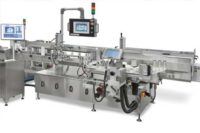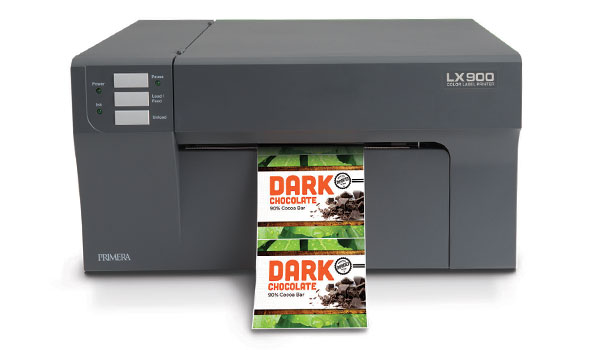Machinery Technology: Labeling
Labeling from start to finish
New labeling machinery delivers improvements for primary packaging to tertiary packaging.








Labeling and printing machinery today must address growing customer desires for speed, flexibility and positive user experience. Advancements in this segment address these concerns and more as a new wave of machinery makes its debut.
When time is of the essence and a slow-moving printer just won’t do, Primera (primeralabel.com) has launched its fastest inkjet color label printer. The new LX900 Color Label Printer produces labels at speeds of up to 4.5” per second – almost 17 times faster than Primera’s best-selling LX810 Color Label Printer (for comparable print quality). Separate ink cartridges for cyan, magenta, yellow and black keep operating costs low since only one color at a time needs to be replaced. The semi-permanent print head utilizes new technology to produce brilliant graphics, sharp text and photo-realistic printing on a dedicated short-run label printing device.
“LX900 establishes a new industry standard for print speed, print quality and low operating costs,” says Mark D. Strobel, Primera’s vice president of sales and marketing. “We listened carefully to our users. They told us that faster printing and separate ink tanks were the most important new features we could offer. At the same time, they weren’t willing to sacrifice the excellent print quality they were getting from their existing Primera color label printer.”
The LX900 is ideal for use with product labels for coffee, wine, water, bakery, confectionary, meat, cheese and hundreds of other specialty and gourmet foods.
For touchless label application, Diagraph (diagraph.com), an ITW Company, announces the All-Electric Tamp-Blow Label Applicator module. Through a touchless label application, labels are automatically applied using nothing more than a servo-driven actuator and an industrial high-volume fan. The actuator provides repeatable placement accuracy and the fan creates vacuum hold and blow projection of the label.
Because the product is not handled during label application, this system is ideal for delicate or irregular surfaced products. With the tamp-blow application module, the actuator extends a preset (or variable) distance close to the product and the label is then applied with a final burst of air.
Unlike alternatives that utilize compressed air, the electric system is very power efficient, and lacks the issues associated with needle valves and dirty/oily/water-contaminated air. The system also lacks the need to make constant compensating adjustments. The advantages to end users are increased uptime with servo precision, repeatable operation through all-digital controls, and ease of use through one-time adjustment.
At the end of the line, labelers are still needed to add valuable information to packaged goods. Domino’s (domino-printing.com) new customizable pallet labeler does just that. Domino has expanded its successful M-Series range of print and apply labelers with the introduction of the new M220. An off-shelf pallet labeler that can be configured to suit different applications, the M-Series’ latest addition is able to meet the tertiary labeling requirements within a diverse range of packaging lines.
With a design based on over 20 years’ experience working in the palletizing sector, the M220 features a new tamp head that allows 180-degree movement, therefore allowing labels to be applied on up to two adjacent sides of the pallet as dictated by the customer requirement and production line layout. This feature not only reduces lead times, but also grants the system a high degree of adaptability that will appeal to all users.
The M220 is available in either aluminum or stainless steel and both versions have optional label check scanners and a climate control unit. The stainless steel version is particularly suitable for harsh environments found in the beverage sector, as it is more durable and can be easily cleansed and sterilized in order to guarantee a clean production environment at all times.
“The system is designed to fit on a single Euro Pallet, which allows us to minimise shipment space, thus reducing shipping costs and also cutting down the carbon footprint in the process,” says Peter Lister, product manager for secondary packaging at Domino.
New water-based flexo dispenser program for narrow web printers

|
|
NWTL printers that use water-based flexo inks can decrease operating expenses in ink volume and ink costs by up to 25%. |
Narrow web tag and label (NWTL) printers that use water-based flexo inks can now decrease their overall bottom-line operating expenses in ink volume and ink costs by up to 25% with the new Sun Chemical (sunchemical.com) Water-Based Flexo Dispenser Program.
The newest version of Sun Chemical’s highly successful Dispenser Program for commercial and NWTL printers, allows NWTL printers to mix exactly the amount of water-based flexo inks that they need. This practice reduces inventory and waste, improves color-matching consistency and decreases total operating costs. The water-based flexo dispenser is unique in that it can make process, blending bases and spot colors all from the same machine. Color concentrates and technology extenders can be dispensed to make inks for more than one application, providing printers the flexibility to control color density and compensate for various anilox configurations.
“In the narrow web market, printers are looking for versatility—the ability to make process, spot and blending bases all on the same dispenser,” says Brian Breidigan, vice president, product manager commercial, North American Inks, Sun Chemical. “Our water-based dispenser program does that and more. The dispenser brings a small footprint to the pressroom, and customers can participate in the program at no risk or additional cost for upkeep. More importantly, it can save printers a significant amount of money by reducing inventory and waste.”
Looking for a reprint of this article?
From high-res PDFs to custom plaques, order your copy today!











